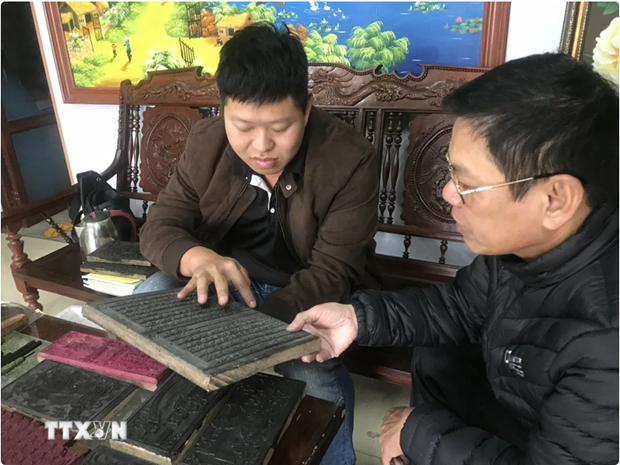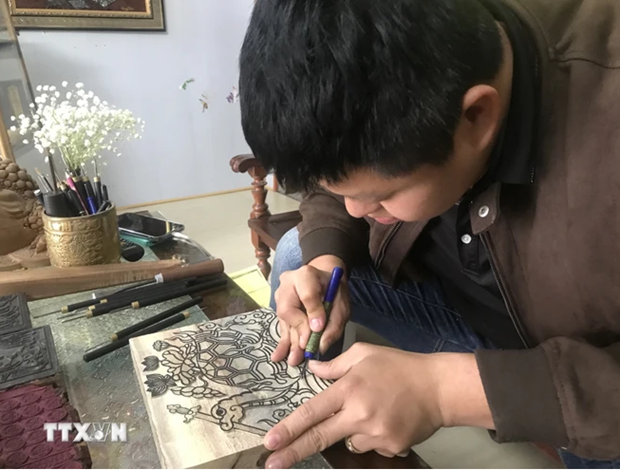Hai Duong province preserves 500-year-old woodblock printing craft
Once being the national centre of woodblock printing, spanning from the 15th to the 19th centuries, Thanh Lieu village in Hai Duong city in the province of the same name has preserved thousands of sets of scriptures and seals.

During the traditional festival held at Thanh Lieu temple in late February in Thanh Lieu residential area, Tan Hung ward, Hai Duong city, many visitors were delighted to learn about the 500-year-old craft in this area.
The exhibition space featured works as well as the list of nearly 100 local artisans, providing an insight into the long-standing woodblock printing craft in the locality.
According to an ancient book on Hai Duong’s geography, the forefather of the craft was Luong Nhu Hoc, born in 1420, in Hong Luc village, Thach Khoi commune, Truong Tan district (now Tan Hung ward, Hai Duong city).
After two diplomatic missions to China, Hoc brought back the craft and taught it to residents in Thanh Lieu, Lieu Trang, and Khue Lieu villages.
Some documents about Vietnamese craft villages reveal that Hoc’s first two apprentices were Pham Nien (Pham Tren) and Pham Doi (Pham Duoi). They helped spread woodblock printing in Hong Luc and Lieu Trang, and even Khue Lieu village.
The three villages formed the national centre of woodblock printing, from the 15th to the 19th centuries, during which strong men carved woodblocks, while women and children printed, and cut and trimmed paper.
The craft brought about relatively affluent lives to residents in the three villages at that time.
Local artisans said the craft requires meticulousness in all steps, from selecting wood to carving, preparing ink and rolling it onto woodblocks. The wood must be soft, and the paper must be poonah (known locally as “do” paper) to ensure the quality of the print.
It takes a craftsman from three to five days to complete one carved woodblock. However, some may take several months, depending on the length of the text, and the theme requested by clients. For many carvings, characters were as small as grains of rice, making it difficult for artisans to complete without thorough education.
To become a woodblock printing artisan, one must undergo an average of three years of apprenticeship. They must be proficient in Han (Chinese script), understand writing rules, and recognise reversed characters because the woodblock carving is done in reverse, so that the print appears correctly. Woodblock printing is largely inherited through family lineage and traditional practices.
To carve scriptures, one must be a skilled artisan. By the end of the Nguyen dynasty (1802-1945), in Lieu Trang and Thanh Lieu villages, there were hundreds of woodblock carvers, but only about 20 were proficient enough to carve scriptures.

Over hundreds of years, Thanh Lieu village printed thousands of sets of scriptures and seals. Notably, the woodblocks from the Nguyen Dynasty, recognised by the United Nations Educational, Scientific and Cultural Organisation (UNESCO) as the first World Documentary Heritage in Vietnam in 2009, saw the great contributions of local artisans.
The villagers then ventured out to make a living and introduced the craft to other regions across the country. Many printing workshops in Ha Noi’s old streets of Hang Trong and Hang Gai were mainly run by people from Thanh Lieu, Lieu Trang, and Khue Lieu villages.
Like many other traditional crafts, woodblock printing in Thanh Lieu faces the risk of fading away as only a few households remain closely associated with this traditional profession.
Nguyen Van Dan, Secretary of the Party Committee of Tan Hung ward, said to preserve it, the ward is collaborating with relevant agencies to develop a project on the recognition of the craft village.
Local authorities are also working with artisans both in and outside the village to collect prints to pass on woodblock printing techniques to younger generations, he added.
TB (according to VNA)
